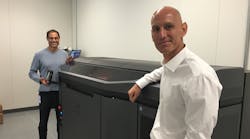If you set up enough Google News alerts and RSS feeds, you can fill your inbox with incredible stories about additive manufacturing and 3D printing pretty much every day. Late last year, for example, Dutch printing company MX3D turned to a pair of robotic arms to 3D print a bridge over an Amsterdam canal. Earlier this year, the United Arab Emirates National Innovation Committee announced plans to 3D print a Dubai office building. And just last month, stem cell research leader Celprogen revealed a 3D-printed heart populated with human cardiac cells.
Bridges and buildings and human hearts snag headlines, of course, but how will the technology affect manufacturing in the quarters and years ahead? Stronger parts? Shorter cycles? Overhauled supply chains?
Jabil Circuit is starting to find out that the answer to all those questions is yes.
Jabil, the Florida-headquartered contract manufacturer that has worked with some of the biggest names in tech since it was founded 50 years ago, recently partnered with Hewlett-Packard to incorporate the new Multi Jet Fusion 3D Printing Solution. HP is billing its system as the first in the world ready to produce 3D parts and products — and at blazing speeds, as quick as 340 million voxels per second, about 10 times faster than any other printer available.
To hear Jabil global automation and 3D printing VP John Dulchinos tell it, the company has listened to its customers’ questions for years about how to accelerate the product innovation process. “‘How do I get my products to market before my competition?’” they ask. “‘How do I drive and secure innovation at a pace that allows us to continue to grow?’”
This combination of HP hardware and Jabil execution has already helped companies move more quickly from napkin to prototype, and from prototype to production. Hyperbole tends to be high in technology, but this could — and probably should — disrupt the whole supply chain.
Partners From the Foundation on Up
The HP Multi Jet Fusion 3D printers will reportedly start at $130,000 and $155,000, depending on the model, and while they aren’t on the market yet, Jabil has worked with HP long enough and well enough to land a foundational partnership for the new tech. Other foundational partners include Johnson & Johnson, Nike and BMW. Dulchinos says Jabil pitched itself as more of a “real” manufacturer, deep in production at scale, at cost, at levels of high quality and high repeatability. “There’s a world of difference between just hitting print,” he says, “and just doing all that faster.”
Though the MJF system will allow Jabil — and other future users — to do all that faster. The system deposits fusing and detailing agents on a powder layer, with infrared lamps set to fuse that layer together. The powder bed opens the door for geometric shapes at least as complex as those printed on selective laser sintering machines — at those far faster speeds.
“We went through a model of what it took to create a consumer-grade product using a traditional molding process, kind of how you would go through that,” Dulchinos says. “Best case is a 65-day process. If we can go from part to 3D printed part, we can do a tight, iterative cycle, and once we’re done, we can just starting making parts instead of going through this typical process — make a mold, wait for it, make some changes, refine it again and again. This, we can do in 16 days. We think it can completely change the process. You can really accelerate your ability to launch a plastic part into production.”
One internal estimate cuts the product life cycle from napkin to production from about six months down to seven or eight weeks. Still, additive manufacturing is just one step in the process. There are a number of other steps required, many of which require fixes at scale. Fail to accelerate those steps as well, and the process probably hasn’t shed much time.
Jabil is focused on providing additive manufacturing as a service, Dulchinos says — along with digital prototyping, managed supply chain services and managed procurement services — with a goal of taking “additive manuffacturing into the production of real parts and into manufacturing.”
“Most 3D printing companies think that using 3D printing in manufacturing is simply prototyping at scale,” Dulchinos says. “‘Let’s take our toolbox and figure out how to make it go faster, or at a lower cost, and then we can open up manufacturing.’ For us, the difference between prototyping and manufacturing is twofold. The first part is that there is absolutely a cost element to it. If you can’t drive the finished-part cost to a level that makes sense, then it’s not going to be used. The second part, equally important, is that you need to have a process that you can trust to deliver on a repeatable basis.”
Jabil works with the HP printers at its tech-focused Blue Sky Center in San Jose, each of them measuring 4 feet deep by 8 feet long, tucked away in the Black Box Room. “We don’t have a build-it-and-they-will-come perspective for this,” Dulchinos says. “The rollout will be driven by where our customers are moving this, and in the near term, I think it will be somewhat traditional parts that are produced using 3D printing, and then, over time, that will shift to new business models.”
Work has started, though.
Improved Products and Improved Bottom Lines
Even before Jabil installed the new tech, it had started to explore the possibilities of additive manufacturing as a ever-increasing part of the supply chain, according to COO Bill Muir. Superfeet Worldwide is among the companies that have benefitted.
IndustryWeek is a New Equipment Digest companion site within Penton's Manufacturing & Supply Chain Group.











